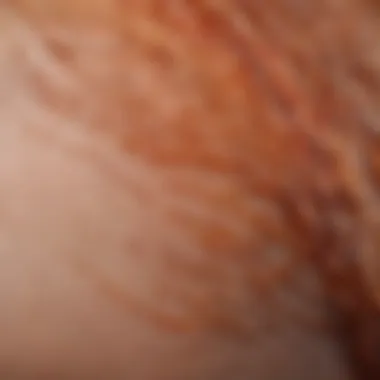Understanding and Treating Hair Bumps Effectively


Intro
Hair bumps, medically known as folliculitis, are a common skin issue that can arise in both men and women. These bumps form when hair follicles become inflamed, often leading to discomfort or irritation. Understanding the underlying causes of hair bumps is essential for effective prevention and treatment.
A range of factors can contribute to this condition. These include friction from clothing, poor hygiene, and certain skin conditions. It is crucial to recognize that while hair bumps are typically not serious, their presence can affect one's confidence and overall well-being. Through exploring various remedies, lifestyle changes, and professional options, this article aims to offer comprehensive strategies for managing hair bumps effectively.
By delving into the causes and treatments available, we can equip readers with practical tools to maintain healthy skin and hair. This discussion is particularly relevant for women of all ages, who may find themselves dealing with this issue due to various hairstyling practices or products.
With an understanding of both the condition and the available solutions, it is possible to embrace a head of healthy hair and clearer skin. In the coming sections, we will explore these themes in depth.
Defining Hair Bumps
Understanding hair bumps is essential for anyone dealing with skin health issues related to hair follicles. Hair bumps, also known medically as folliculitis, signify inflammation of the hair follicles. This inflammation can lead to discomfort and unsightly skin conditions, impacting both appearance and confidence.
This section will focus on defining what hair bumps are and identifying their common symptoms. Recognizing hair bumps is crucial for effective management and treatment options. Without a clear understanding, many individuals may mistake them for other skin conditions or ignore necessary preventative measures. By providing detailed information, this article aims to empower women of all ages to take proactive steps in their hair and skin care routines.
What Are Hair Bumps?
Hair bumps appear as small red or brown spots on the skin where hair follicles are present. They are often the result of inflamed hair follicles due to several factors, such as irritation, infection, or underlying skin conditions. The bumps may occur following hair removal practices like shaving, waxing, or threading. Some people may experience hair bumps more intensely in sensitive areas such as the bikini line or neck, where friction can worsen the irritation.
While hair bumps are generally not serious, they can lead to more significant issues if left unchecked. For example, persistent irritation may result in secondary infections. It is vital to recognize that any hair bump may indicate an underlying problem, warranting a closer examination of habits and techniques related to hair care.
Common Symptoms
Identifying the symptoms of hair bumps can assist in early intervention and treatment. Typical symptoms of hair bumps include:
- Redness and inflammation around the hair follicles.
- Pimples or small pustules, which may have a white or yellow head.
- Itching or tenderness in the affected areas.
- A sensation of pain or discomfort, particularly during contact with clothing.
In some cases, people may also notice scabbing or crusting over affected areas. It is crucial to monitor these symptoms as they could indicate a worsening condition or infection needing professional assessment. To avoid complications, timely recognition and response to hair bumps are imperative.
Causes of Hair Bumps
Understanding the causes of hair bumps is crucial for effective management and prevention. Hair bumps often occur due to irritation, infections, or underlying skin conditions. By identifying the source of these bumps, individuals can take proactive steps to alleviate discomfort and prevent future occurrences. Each factor plays a distinct role in the formation of hair bumps and offers different avenues for treatment.
Irritation from Hair Removal
Hair removal practices can be a major contributor to the development of hair bumps. Methods such as shaving, waxing, or using depilatory creams can cause irritation to the hair follicles. When the skin is not handled properly, it may lead to inflammation, resulting in red, itchy bumps that can be unsightly.
It is important to recognize the proper techniques for hair removal. For example:
- Shaving: Always use a clean, sharp razor. Shaving in the direction of hair growth can help minimize irritation. Using a moisturizing shaving cream is essential.
- Waxing: Ensure that the wax is not too hot and is applied evenly. Aftercare is equally important to soothe the skin.
- Depilatory creams: Conduct a patch test first to check for skin sensitivity. Follow the directions carefully to avoid burns or irritation.
Taking these precautions can significantly reduce the likelihood of hair bumps forming after hair removal.
Infections and Folliculitis
Infections, particularly folliculitis, are another prominent cause of hair bumps. Folliculitis occurs when hair follicles become infected, typically due to bacteria or fungi. This condition can be exacerbated by factors such as wearing tight clothing or excessive moisture near the skin. Understanding the symptoms of folliculitis is key. Common signs include:
- Red, inflamed bumps around hair follicles
- Pus-filled sores
- Itching or burning sensations
Prevention is possible by practicing good hygiene. Keeping the skin clean and dry will limit the chances of infection. If folliculitis is suspected, it is advisable to consult a healthcare professional for appropriate treatment options.
Skin Conditions
Certain skin conditions can predispose individuals to hair bumps. Conditions like eczema, psoriasis, and keratosis pilaris can affect the skin's texture and health, making it more susceptible to irritation and inflammation. People with sensitive skin may find they are more prone to hair bumps due to these underlying issues.
Addressing these skin conditions can often lead to a decrease in hair bumps. Regular moisturizing can help maintain skin integrity. Additionally, treatment for specific conditions, prescribed by a dermatologist, can provide relief and improve overall skin health.


Understanding the causes of hair bumps is essential for effective management and prevention. By identifying the source, proactive steps can be adopted to alleviate discomfort.
Awareness of these factors is a significant step toward achieving clearer skin and managing hair bumps effectively. Taking the time to understand the underlying issues can empower individuals to make informed choices about their hair and skin care.
Prevention Strategies
Preventing hair bumps is critical for maintaining healthy skin and avoiding discomfort. Addressing the causes of hair bumps through proactive strategies can significantly reduce their occurrence. Quick relief may be sought through treatments, yet preventing the bumps in the first place minimizes long-term issues. Understanding various prevention methods empowers individuals, equipping them with knowledge to make informed choices about their skin and hair care.
Choosing the Right Hair Removal Method
The hair removal technique chosen plays a pivotal role in preventing hair bumps. Several methods vary in their potential for causing irritation:
- Shaving: While common, it's essential to use a sharp razor and shave in the direction of hair growth. This reduces skin irritation and the risk of ingrown hairs.
- Waxing: Although effective for longer-lasting results, waxing can lead to inflammation for some people. It's important to ensure the wax is suitable for your skin type.
- Laser Hair Removal: This method offers a long-term solution by targeting hair follicles. However, it may involve multiple sessions and should be performed by a certified professional.
Selecting a method tailored to individual skin sensitivity is vital. Also, consider performing patch tests with new products to assess reactions. Keeping skin calm and well-nourished further aids in minimizing the risk of hair bumps.
Importance of Hygiene and Skin Care
Hygiene practices are integral to skin health and, consequently, the prevention of hair bumps. Proper skincare routines allow for the maintenance of clean and clear pores. Here are some key practices to consider:
- Clean Skin: Regularly cleansing the skin, especially before and after hair removal, can remove bacteria that lead to infections.
- Moisturization: Hydrating the skin aids in its repair and can help prevent clogged hair follicles.
- Exfoliation: Gentle exfoliation 1-2 times per week can remove dead skin cells. This process prevents the buildup that often leads to bumps.
- Avoiding Tight Clothing: Tight clothing can rub against the skin, causing irritation. Opt for looser attire, especially after hair removal.
Maintaining a strong hygiene and skincare regime not only enhances the skin's appearance but serves as a preventative barrier against hair bumps.
"Taking care of your skin is an investment, not an expense."
In summary, creating awareness around suitable hair removal methods and robust hygiene encourages individuals to make better choices for their skin health. Education on these topics offers significant benefits, steering people away from common mistakes that may contribute to hair bumps.
Topical Treatments
Topical treatments play a crucial role in managing hair bumps, commonly known as folliculitis. These treatments can target skin inflammation, reduce redness, and expedite healing times. Understanding both over-the-counter options and prescription medications gives patients a comprehensive view of how to effectively address this condition. Moreover, topical treatments offer localized relief, minimizing potential systemic side effects from oral medications.
Over-the-Counter Options
For many, over-the-counter (OTC) treatments represent the first line of defense against hair bumps. These solutions are easily accessible and can provide relief without the need for a prescription. Common OTC options include:
- Salicylic Acid: Helps in exfoliating dead skin cells, clearing clogged hair follicles.
- Benzoyl Peroxide: Known for its antibacterial properties, effective against the bacteria that can contribute to folliculitis.
- Hydrocortisone Cream: Useful for reducing inflammation and itching.
- Topical Antiseptics: Help in preventing infection and keeping the area clean.
When using OTC treatments, it is vital to follow the instructions on the packaging. Overuse can lead to dryness or irritation. It is also important to patch test any new product to avoid adverse reactions.
Prescription Medications
In more severe cases or when OTC treatments fail, prescription medications may be necessary. A healthcare professional can assess the situation and recommend appropriate options. These consist of:
- Topical Antibiotics: Such as clindamycin and mupirocin, these target and eliminate bacteria effectively.
- Retinoids: Help in skin cell turnover and can prevent hair follicles from becoming clogged.
- Corticosteroids: Stronger formulations can be prescribed for reducing inflammation in more severe instances.
- Antifungal Creams: If fungi are the underlying cause, antifungal medications can treat the infection.
Professional guidance is essential when using prescription medications. Each has specific application methods and potential side effects. Regular follow-up can also ensure that the treatment strategy is effective and well-tolerated.
Important Note: Always consult a healthcare provider before starting any new treatment regimen to ensure it aligns with individual health needs and conditions.
Home Remedies
Home remedies hold significant importance when addressing hair bumps. Many individuals prefer these natural approaches as they often use readily available ingredients, minimizing expenses and reducing exposure to potential chemicals found in commercial products. Moreover, home remedies can be effective in managing symptoms such as inflammation, irritation, and discomfort, providing immediate relief and promoting skin health without invasive treatments.
When considering home remedies, it is essential to recognize that consistency and patience are key. While some solutions may yield quick results, others require time to show visible improvements. Additionally, understanding individual skin types is crucial when selecting remedies, as various approaches may work differently based on personal conditions.
The following sections will detail natural solutions known for their anti-inflammatory properties and simple exfoliation methods that can enhance the skin's appearance and health.
Natural Anti-Inflammatory Solutions


Natural anti-inflammatory solutions can play an effective role in alleviating hair bumps. Ingredients such as aloe vera, tea tree oil, and witch hazel have gained popularity for their soothing and healing effects on the skin.
- Aloe Vera: This succulent contains polysaccharides, known for their hydrating and healing properties. Applying aloe vera gel directly onto the affected area can reduce redness and swelling. The cooling effect offers immediate comfort.
- Tea Tree Oil: With its well-documented antibacterial and anti-inflammatory qualities, tea tree oil serves as a potent antiseptic. Diluting a few drops of this oil with a carrier oil can be beneficial. It is important to conduct a patch test to avoid adverse reactions.
- Witch Hazel: Known for its astringent properties, witch hazel works to tighten the skin and decrease inflammation. Applying witch hazel extract may help diminish the appearance of bumps while also preventing irritation.
Applying these remedies consistently can support overall skin health and promote a clearer complexion.
DIY Exfoliation Methods
DIY exfoliation methods can help in managing hair bumps by removing dead skin cells, preventing clogged pores, and promoting new cell regeneration. Regular exfoliation can lead to improved skin texture and a healthier appearance. Here are some methods to consider:
- Sugar Scrub: Mixing sugar with coconut oil can create a gentle scrub suitable for sensitive skin. Sugar acts as a natural exfoliant, while coconut oil moisturizes the skin, preventing dryness.
- Oatmeal Scrub: Ground oatmeal mixed with honey can be an effective solution. Oatmeal possesses soothing properties and helps to calm irritated skin. Gently scrubbing this mixture can provide a mild exfoliation without causing additional irritation.
- Baking Soda Paste: Using a baking soda and water paste can be an occasional, deeper exfoliation method. Its granular texture helps remove dead cells. However, it is crucial to avoid overuse, as it may disrupt the skin's natural balance.
Implementing these methods properly can lead to the reduction of hair bumps while enhancing skin clarity and texture. Remember to moisturize afterward to maintain skin hydration.
Lifestyle Adjustments
Lifestyle adjustments play a pivotal role in managing hair bumps, also known as folliculitis. Small changes in daily habits can yield significant benefits for both skin and hair health. These adjustments focus on enhancing overall well-being while addressing the specific triggers that cause hair bumps. By considering dietary choices and stress management techniques, individuals can improve skin resilience and reduce the chances of developing hair bumps.
Dietary Considerations for Skin Health
Diet directly influences skin health and can either aggravate or alleviate skin concerns. Incorporating nutrient-rich foods can promote healing and support skin integrity. A balanced diet rich in vitamins A, C, E, and omega-3 fatty acids is essential. Fruits and vegetables, such as berries, oranges, and leafy greens, offer antioxidants that combat inflammation. Fatty fish, like salmon and mackerel, provide omega-3s, which have anti-inflammatory properties.
Certain foods should be limited to decrease irritation. Processed foods, high-sugar items, and excessive dairy can trigger skin problems. Instead, focus on whole grains, nuts, and seeds. Hydration is also vital. Adequate water intake helps maintain skin elasticity and flushes out toxins. A simple rule of thumb is to aim for at least eight cups of water daily, adjusting as necessary based on activity levels.
Stress Management Techniques
Stress is often an overlooked factor in skin health. It can trigger hormonal imbalances that worsen conditions like hair bumps. Effective stress management techniques can help maintain hormonal equilibrium and improve skin response.
Practices such as mindfulness meditation, deep breathing, and yoga are beneficial. Set aside a few minutes each day to practice mindfulness. Focusing on the breath can effectively reduce stress levels. Similarly, yoga can promote relaxation and improve circulation, positively affecting skin health.
Regular physical exercise is another powerful stress relief method. Not only does it help release endorphins, but it also encourages better sleep, which is essential for skin recovery. Aim for at least 150 minutes of moderate aerobic activity each week.
Managing stress comprehensively supports skin health and prevents flare-ups of hair bumps.
In summary, dietary and lifestyle adjustments play crucial roles in promoting healthy skin. Eating a balanced diet and practicing effective stress relief techniques are essential steps toward minimizing hair bumps and enhancing overall skin vitality.
Professional Treatments
Professional treatments play a crucial role in addressing hair bumps, particularly when at-home remedies are insufficient. Visiting a qualified professional can provide tailored solutions that directly target the underlying causes of hair bumps, which primarily occur due to inflammation of hair follicles.
Consulting a Dermatologist
Visiting a dermatologist is often the first step in managing persistent hair bumps. A dermatologist can evaluate the condition of your skin and diagnose the specific type of folliculitis you may be experiencing. Often, they will conduct a thorough examination and may even take a sample if an infection is suspected.
The benefit of consulting a specialist is the ability to receive personalized treatment recommendations. Dermatologists can prescribe medications that are more effective than typical over-the-counter solutions. For instance, they may suggest topical antibiotics or corticosteroids to reduce inflammation and fight infection. Furthermore, a professional can help you understand any underlying conditions contributing to hair bumps, such as acne or eczema, leading to more comprehensive care strategies.
"Consulting a dermatologist provides clarity and direction in treating skin issues like hair bumps effectively."
Advanced Laser Treatments
For those who seek quicker and perhaps long-term solutions, advanced laser treatments offer a viable option. Laser therapy targets hair follicles with concentrated light beams. These procedures can eliminate hair with the added benefit of reducing the risk of folliculitis recurrence. By inhibiting hair growth, laser treatments minimize the chances of irritation and reduction in bumps.
Not only does this method reduce visible hair, but it can also help in fading discoloration that may accompany hair bumps due to irritation. It’s essential to consult with a licensed practitioner who specializes in laser treatments to discuss individual skin types and expectations. Be aware that multiple sessions may be required to achieve desired results, and while effective, these procedures tend to be more costly compared to other treatments.
The choice of treatment should always align with personal skin type and severity of the condition. Each method has specific pros and cons which should be thoroughly discussed with your dermatologist.
When to Seek Medical Attention
Recognizing when to seek medical attention for hair bumps is an important part of managing this condition effectively. Hair bumps can sometimes be a minor annoyance, but they can also signal a more serious underlying issue. Understanding the signs that warrant a visit to a healthcare provider is crucial.


Several factors can determine whether immediate medical input is necessary. If the bumps become painful, or if there is persistent itching that does not respond to over-the-counter treatments, these may be indications that professional assistance is needed. Additionally, any changes in the appearance of the bumps should be closely monitored. If the bumps change in color, size, or start to discharge pus, a consultation with a healthcare provider is advisable.
Seeking medical help can lead to better treatment options tailored to the individual's needs. It may also prevent worsening of the situation. This proactive approach benefits skin health in the long run.
Recognizing Severe Symptoms
Severe symptoms related to hair bumps may indicate a need for medical attention. These symptoms include extreme pain, swelling, and the development of fever or chills. If hair bumps are large and tender, these might indicate an infection rather than simple folliculitis.
Some warning signs to look for are:
- Fever or chills: This could indicate an infection.
- Increasing redness or warmth: This suggests inflammation or infection.
- Pus formation: If you see pus, it’s best to consult a doctor.
- Severe hair loss: If you notice patches of hair loss, professional evaluation is necessary.
If any of these symptoms arise, do not hesitate to consult a medical professional. It is always better to err on the side of caution.
Indicators of Infection
Identifying signs of infection is essential in the management of hair bumps. Folliculitis or hair bumps can get infected easily, especially if they are scratched or irritated. Common indicators of infection include:
- Persistent red and swollen bumps.
- Foul-smelling drainage from the bumps.
- Increased pain in the affected area.
- Development of abscesses, where a lump fills with pus.
Infections can escalate rapidly, requiring timely medical intervention. Ignoring these kinds of symptoms could lead to complications. If you suspect an infection, it's important to reach out for medical help immediately. This ensures the best outcome and promotes overall skin health.
Expected Outcomes
Understanding the expected outcomes when dealing with hair bumps is essential. Hair bumps, or folliculitis, can pose cosmetic and physical discomforts that often diminish one's confidence. Anticipating the recovery prospects and focusing on long-term skin health are crucial steps in managing this skin issue effectively. With the right approach, individuals can restore the health of their skin and minimize the chances of future occurrences.
Prospects for Recovery
The prospects for recovery from hair bumps can vary widely among individuals. Typically, with proper treatment and care, the majority of cases can see improvement within a few days to weeks. Effective management involves several key factors:
- Timely Intervention: Recognizing symptoms early and seeking appropriate treatment can shorten recovery time.
- Treatment Consistency: Adhering to prescribed topical treatments or remedies is crucial. Following a consistent regimen improves the chances of achieving the desired skin clarity.
- Personal Skincare Routine: Developing a daily skincare routine that addresses skin hygiene and moisturizing can support healing.
- Professional Guidance: In cases that persist or worsen, consulting a dermatologist allows for a tailored treatment plan. Medications or advanced therapies may be necessary to achieve optimal results.
Overall, understanding personal skin responses and being proactive leads to
better recovery outcomes and healthier skin in the long term.
Long-Term Skin Health
Long-term health of the skin goes beyond just treating hair bumps. It is a comprehensive approach that emphasizes prevention and mindful care. Here are several considerations to promote lasting skin health:
- Preventative Measures: Regularly employing preventive strategies such as selecting appropriate hair removal methods can greatly reduce the occurrence of hair bumps.
- Nutritional Support: A balanced diet rich in vitamins and antioxidants can support skin regeneration and overall health. Foods high in omega-3 fatty acids and hydration are beneficial for maintaining skin elasticity and moisture.
- Stress Management: High levels of stress can adversely affect skin conditions. Practicing relaxation techniques such as meditation or yoga can help maintain skin health.
- Regular Skin Assessments: Keeping track of skin changes is important. Monitoring changes and seeking professional advice when necessary helps manage skin health proactively.
In summary, the emphasis on recovery and long-term health highlights the importance of a systematic approach to managing hair bumps. With rigorous attention and appropriate practices, individuals can enjoy not only better skin but also boost their overall confidence.
End
The conclusion of this article plays a vital role in distilling complex information about hair bumps into actionable insights. It allows readers to reflect on the multifaceted nature of folliculitis and appreciate the implications of proper management. By summarizing the key points discussed throughout the article, it emphasizes the importance of recognizing symptoms and understanding their causes.
Summarizing Solutions
As we wrap up this exploration, it is essential to underscore the diverse strategies for addressing hair bumps. The solutions range from appropriate topical treatments to effective home remedies. Each approach offers distinct benefits that cater to individual preferences and skin types.
- Topical Treatments: Utilizing over-the-counter options can provide immediate relief from irritation. Prescription medications, when necessary, address more severe cases effectively.
- Home Remedies: Natural solutions like aloe vera or tea tree oil can soothe inflammation and promote healing. These remedies often appeal to those seeking gentler alternatives.
- Lifestyle Adjustments: Dietary considerations and stress management techniques can significantly enhance skin health in the long run, reducing the frequency and severity of hair bumps.
Overall, adopting a comprehensive approach can empower women to tackle hair bumps confidently. By exploring these methods, individuals can build a tailored skincare routine that prioritizes their wellbeing.
Encouragement for Personal Care
Ultimately, encouraging personal care is fundamental in the context of managing hair bumps. Understanding that one's self-care routine has profound effects on skin and hair health fosters a proactive mindset. Investing time in appropriate skin care practices is not merely a cosmetic endeavor but a vital component of overall health.
Being informed about the various options available allows for better decision-making. Taking steps to improve one’s hygiene, choosing the right hair removal methods, and engaging in practices that support skin integrity will yield positive results.
Fostering a mindset that prioritizes healthy habits can lead to satisfaction and improved confidence. Don’t hesitate to take the necessary measures; your skin deserves it. Remember, it’s not just about treating issues as they arise, but also about nurturing and protecting your skin from future problems.
Taking proper care of your skin is an ongoing journey, essential for maintaining health and beauty.



